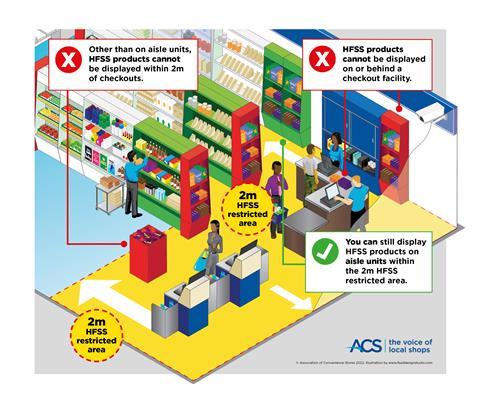On the surface, exemptions to the HFSS rules are simple: small businesses with fewer than 50 employees are free of the location restrictions and any future volume promo bans, regardless of the size of the store.
But franchise agreements comlicate matters. On paper, this should mean many convenience stores dodge the new rules completely. Unfortunately, it’s not that straightforward.
The reason is that convenience retailers deemed to have a ‘franchise agreement’ must count staff numbers based on all employees within the franchise business or symbol group they are part of, not just the people directly employed in store.
In other words, an independent retailer who might only have 20 employees could still be subject to location restrictions if their stores are over 2,000 sq ft – though some have circumvented this by reducing floor space to comply, adding a Post Office, stock room, seating areas, and parcel lockers, among others.
Still, many are worried. As James Lowman, CEO at the Association of Convenience Stores writes in this week’s issue of The Grocer (p22): “There are now thousands of businesses that have had to reorder, refit and reimagine their stores at great cost, waiting for a potential visit from an enforcement officer with a tape measure.”
It doesn’t seem to help that this rule applies regardless of the arrangements retailers may have with their symbol or franchise group. That’s why retailers are still advised to seek legal advice on the status of their contracts, either via their symbol or franchise head office, or by sourcing it themselves.
Take Nisa, for example. After “rigorously” reviewing the HFSS regulations, its interpretation of the definition found that Nisa retailers should not be classified as franchisees. As most of them have fewer than 50 employees, the symbol group deemed the majority should not be affected by the location restrictions.

“Our position does not preclude any Nisa customer from obtaining their own independent legal advice on the interpretation of the regulations should they wish to do so,” adds a Nisa spokeswoman.
However, as Lowman warned back in April, “there is still a lot of interpretation that will be left up to enforcement officers when the regulations come into force”.
That stage of the HFSS law is now upon us, as the locational restrictions kicked off last week. The ACS says it hasn’t heard of any initial concerns from retailers about their compliance, following the decisions, based on the legal advice they sought. However, the trade body will be “keeping an eye on” the situation as Trading Standards visits start happening across the country.
“Retailers have spent a lot of time and money preparing for the introduction of HFSS regulations, but we now enter the next phase, which involves enforcement officers checking compliance in stores, both in terms of individual store solutions and whether or not the store is exempt,” says the ACS’s Lowman.
“We will be working closely with our Trading Standards partner Surrey and Buckinghamshire to get feedback on what the outcomes of these visits are and whether any additional issues arise as a result of local interpretation of the regulations.”
A lot of money indeed. The ACS estimated small shops were set to spend £13,000 to comply with the regulations, which rose to £100,000 for larger stores rethinking their layouts. So it’s with little surprise symbol groups and franchises underwent “rigorous” research to ensure whether such a hefty bill was needed.
But at least, for those who are impacted by the regulations, there is evidence that compliance with the HFSS scheme won’t have a negative impact on overall profitability. Southern Co-op began trials in March that saw five stores adapt three different format types to become fully compliant.
The business said the goal of the trial was to develop an understanding of the impact of HFSS regulations on customer behaviour, the costs associated with new formats, and the overall impact on profitability.
While it was expected the largest impact on margins would come from the removal of HFSS products from impulse locations, such as dump bins near tills and queueing areas, no such effect was observed.
“Although we saw behavioural changes in the store, our overarching profitability stayed exactly the same,” says Southern Co-op head of trading and format Andrew Farndell. “In an inflationary market where margin is everything, actually our margin was absolutely what it was pre-trial.”
Everything you need to know about HFSS but were afraid to ask
- 1
- 2
- 3
- 4
- 5
- 6
- 7
 Currently reading
Currently readingHFSS: Small convenience stores call for more detail on exemptions
- 8
- 9




























No comments yet